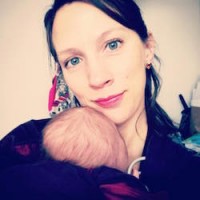How to fall apart, and then pick the pieces back up—and love.
This is part two in a new elephant journal series about love.
To be fair, we never truly heal from broken hearts.
Like flesh repaired, our wounded, bleeding hearts simply form scar tissue.
This article is about how to continue to love—scars and all.
“Have you ever been in love? Horrible isn’t it? It makes you so vulnerable. It opens your chest and it opens up your heart and it means that someone can get inside you and mess you up.”
~ Neil Gaiman
There’s a reason that we build walls around ourselves and our hearts.
Love isn’t only pleasurable and giddy and butterflies in your stomach—it can hurt; it can sting; it can build you up to seemingly tear you down.
However, there’s one problem with constructing barriers around ourselves: they don’t work.
We can still be injured and life can will always be both glorious and miserable—and these self-constructed walls from damage, shame and fear are made of the most breakable glass imaginable.
Because love isn’t strong and hard and rigid.
No, love is pliable and it is strong—strong enough to aqueously bend and contort.
And when we form these shells in order to protect, they actually serve to foster our bitter hardening—they only make us less flexible and able to deal with pain—which is, unfortunately, inevitable.
And these walls—these shells—they are merely fictitiously protective. Rather, we still feel pain and, in addition to this, we become closer to denial and farther from denial’s opposite—which is enlightenment—and love is enlightened.
To love is to know.
To love is to see.
To love is to understand the good and the not so good and the perfect and the undesirable.
To love is to illuminate (to be enlightened of worth, value, and flaw entirely) and to accept completely—and love without restriction.
(This includes self-love and love for others.)
Loving someone doesn’t mean that we’re blind to the reality—instead, it’s the complete reverse.
So how do we tear down our walls? (Because many of us don’t get through life without forming one—regardless of their degrees of thickness and how much others believe them to be our impenetrable truth.)
We do this:
We accept pain.
Love is never exempt from pain.
Even the most brilliant love affairs have ups and downs. (Again, love including with the self or for another.)
Instead of closing yourself off from the hardships of love, you have to bravely anticipate them.
This doesn’t mean we accept cruelty or seek out discomfort, but it does mean that we truly become warriors of love—because if we want to experience these ups, then we have to also go through the downs.
We accept defeat.
We will not always win in love.
We will be disappointed in ourselves from time to time and we will be let down by those we care about most. To love is to be able to accept defeat gracefully. (Although this doesn’t mean that it’s inappropriate to learn from it either.)
One of the most difficult aspects of life is learning not only how to get back up after you’ve fallen, but how to fall in the first place.
Let’s just say that I’ve broken a lot of bones because I, for a long, long time, didn’t know how to fall.
One way to learn this acceptance is to understand, too, that our occasional failings are both opportunities for others to show us love (by helping to pick us back up) or opportunities for others to succeed.
We cannot win every argument—but, equally, this doesn’t mean we have to avoid all confrontation. (And, yes, this is metaphorical.)
We see vulnerability as an asset.
We all have our own talk and some of us walk it and others do not.
My own personal talk (the most important fundamental truth that I try to carry out in all actions, words and thoughts) is to be honest and open—even if this means feeling exposed, vulnerable and raw.
The reason that I live this way (and the reason for nearly all of my blogs) is multi-faceted, but the most important is my child.
You won’t see me discuss her negatively on social media—or much at all, really.
Instead, I’ve chosen to attempt to help shape her into the person I want her to grow into being by living as her example.
And I want her to love herself—I want her to love herself so much that she’s not embarrassed or shamed by qualities that could possibly have been perceived as imperfections.
I want her to love herself so much that societal taboos and stigmas mean nothing to her.
(And that’s why, for instance, I wrote about my ADHD more than once and then shared these articles with you.)
Because loving her starts with me.
It all starts with us.
It begins inside of our hearts—this ability to see the ugly and the unwanted—and to neither ignore it or despise it, but to welcome it with raw, bleeding, wounds made visible.
And glass is formed from supercooled liquids—it’s not a true solid.
And a watery human heart isn’t meant to become embittered—and to harden.
A bleeding, flesh-formed heart is meant to house molten emotions, because it’s in this fragile state that it’s the strongest; when it can light up, and be on fire—and ready to love.
“The moment that you feel, just possibly, you are walking down the street naked, exposing too much of your heart and your mind, and what exists on the inside, showing too much of yourself…That is the moment, you might be starting to get it right.”
~ Neil Gaiman
Relephant reads:
Conversations with a Human Heart.
Want 15 free additional reads weekly, just our best?
Get our weekly newsletter.
Editor: Bryonie Wise
Photos: elephant archives











Read 9 comments and reply